Circular Economy. A Review and Bibliometric Analysis
Abstract
1. Introduction
2. Methodology
3. Results
3.1. Presentation of Results
3.1.1. Web of Science
3.1.2. Scopus
3.1.3. Google Metrics
3.2. Analysis of the Results
3.2.1. Results by Citations Received
3.2.2. Bibliometric Maps of the Results
Bibliometric Map of Authors
Bibliometric Keyword Map
Bibliometric Map of Publishing Organizations
Bibliometric Map of Countries
Bibliometric Map of Quotes Received by Authors
3.2.3. Strategic Diagrams
3.2.4. Analysis of Alternative Metrics
4. Discussion and Conclusions
Author Contributions
Funding
Acknowledgments
Conflicts of Interest
References
- Business Roundtable. Business Roundtable Redefines the Purpose of a Corporation to Promote ‘An Economy That Serves All Americans’. Available online: https://www.businessroundtable.org/business-roundtable-redefines-the-purpose-of-a-corporation-to-promote-an-economy-that-serves-all-americans (accessed on 27 July 2020).
- Amate Fortes, I.; Guarnido Rueda, A. Factores Determinantes del Desarrollo Económico Y Social; Analistas Ecónomicos de Andalucía: Málaga, Spain, 2011. [Google Scholar]
- Stahel, W.R.; Reday, G. The Potential for Substituting Manpower for Energy; Batelle Genebe Research Centre: Geneva, Switzerland, 1976. [Google Scholar]
- Stahel, W.R. The circular economy. Nature 2016, 531, 435–438. [Google Scholar] [CrossRef] [PubMed]
- Stahel, W.R. The Performance Economy, 2nd ed.; Palgrave-MacMillan, Ed.; Palgrave Macmillan: London, UK, 2010. [Google Scholar]
- Segerson, K.; Pearce, D.W.; Turner, R.K. Economics of Natural Resources and the Environment. Land Econ. 1991, 67, 272–276. [Google Scholar] [CrossRef]
- McDonough, W.; Braungart, M.; Anastas, P.T.; Zimmerman, J.B. Applying the Principles of Green Engineering to Cradle-to-Cradle Design. Environ. Sci. Technol. 2003, 37, 434A–441A. [Google Scholar] [CrossRef] [PubMed]
- Hawken, P.; Lovins, A.B.; Lovins, L.H. Natural Capitalism: The Next Industrial Revolution; Routledge: Abingdon-on-Thames, UK, 2013. [Google Scholar]
- Clift, R.; Allwood, J. Rethinking the economy. Chem. Eng. 2011, 837, 30–31. [Google Scholar]
- Rizos, V.; Tuokko, K.; Behrens, A. The Circular Economy a Review of Definitions, Processes and Impacts; Centre for European Policy Studies: Brussels, Belgium, 2017. [Google Scholar]
- Kirchherr, J.; Reike, D.; Hekkert, M. Conceptualizing the circular economy: An analysis of 114 definitions. Resour. Conserv. Recycl. 2017, 127, 221–232. [Google Scholar] [CrossRef]
- Srisruthi, K.M. Circular economy. Int. J. Trend Sci. Res. Dev. 2020, 1, 566–569. [Google Scholar] [CrossRef]
- Lewandowski, M. Designing the business models for circular economy-towards the conceptual framework. Sustainability 2016, 8, 43. [Google Scholar] [CrossRef]
- Ormazabal, M.; Prieto-Sandoval, V.; Puga-Leal, R.; Jaca, C. Circular Economy in Spanish SMEs: Challenges and opportunities. J. Clean. Prod. 2018, 158, 157–167. [Google Scholar] [CrossRef]
- Veleva, V.; Bodkin, G. Corporate-entrepreneur collaborations to advance a circular economy. J. Clean. Prod. 2018, 188, 20–37. [Google Scholar] [CrossRef]
- Heyes, G.; Sharmina, M.; Mendoza, J.M.F.; Gallego-Schmid, A.; Azapagic, A. Developing and implementing circular economy business models in service-oriented technology companies. J. Clean. Prod. 2018, 177, 621–632. [Google Scholar] [CrossRef]
- Ellen MacArthur Foundation. Towards the Circular Economy: Economic and Business Rationale for an Accelerated Transition; Ellen MacArthur Foundation: Cowes, UK, 2013. [Google Scholar]
- European Commission. Cerrar el Círculo: Un Plan de Acción de la UE Para la Economía Circular; European Commission: Brussels, Belgium, 2015. [Google Scholar]
- European Commission. Accelerating the Transition to the Circular Economy—Improving Access to Finance for Circular Economy Projects; European Commission: Brussels, Belgium, 2019. [Google Scholar]
- España Circular 2030: Estrategia Española de Economía Circular; Spanish Goverment: Madrid, Spain, 2018.
- Puentes Cociña, B. ¿España Circular 2030? Comentario al borrador de la estrategia española de economía circular. Rev. Catalana Dret Ambient. 2018, 9, 1–39. [Google Scholar]
- Abadia, L.G.; Galvao, G.D.A.; Carvalho, M.M. Economia Circular: Um estudo bibliométrico. In Proceedings of the En XXXVI Encontro Nacional De Engenharia De Producão, João Pessoa, Brasil, 3–6 October 2016. [Google Scholar]
- Nobre, G.C.; Tavares, E. Scientific literature analysis on big data and internet of things applications on circular economy: A bibliometric study. Scientometrics 2017, 111, 463–492. [Google Scholar] [CrossRef]
- Ruiz-Real, J.L.; Uribe-Toril, J.; Valenciano, J.D.P.; Gázquez-Abad, J.C. Worldwide research on circular economy and environment: A bibliometric analysis. Int. J. Environ. Res. Public Health 2018, 15, 2699. [Google Scholar] [CrossRef]
- Priem, J.; Piwowar, H.A.; Hemminger, B.M. Altmetrics in the wild: Using social media to explore scholarly impact. arXiv 2012, arXiv:1203.4745. [Google Scholar]
- Boretto, J.G. Gestores de Referencias Bibliográficas. Rev. Asoc. Argent. Ortop. Traumatol. 2012, 77, 170. [Google Scholar] [CrossRef]
- Borrego, Á. Altmétricas para la evaluación de la investigación y el análisis de necesidades de información. El Prof. Inf. 2014, 23, 352–358. [Google Scholar] [CrossRef][Green Version]
- López-Robles, J.-R.; Guallar, J.; Otegi-Olaso, J.-R.; Nadia-Karina, G.-R. El profesional de la información (EPI): Bibliometric and thematic analysis (2006–2017). El Prof. Inf. 2019, 28, e280417. [Google Scholar] [CrossRef]
- Champieux, R. PlumX. J. Med. Libr. Assoc. 2015, 103, 63–64. [Google Scholar] [CrossRef]
- Xie, H.; Zhang, Y.; Duan, K. Evolutionary overview of urban expansion based on bibliometric analysis in Web of Science from 1990 to 2019. Habitat Int. 2020, 95, 102100. [Google Scholar] [CrossRef]
- López-Robles, J.R.; Otegi-Olaso, J.R.; Porto Gómez, I.; Cobo, M.J. 30 years of intelligence models in management and business: A bibliometric review. Int. J. Inf. Manag. 2019, 48, 22–38. [Google Scholar] [CrossRef]
- Geissdoerfer, M.; Savaget, P.; Bocken, N.M.P.; Hultink, E.J. The Circular Economy—A new sustainability paradigm? J. Clean. Prod. 2017, 143, 757–768. [Google Scholar] [CrossRef]
- Ghisellini, P.; Cialani, C.; Ulgiati, S. A review on circular economy: The expected transition to a balanced interplay of environmental and economic systems. J. Clean. Prod. 2016, 114, 11–32. [Google Scholar] [CrossRef]
- Lieder, M.; Rashid, A. Towards circular economy implementation: A comprehensive review in context of manufacturing industry. J. Clean. Prod. 2015, 115, 36–51. [Google Scholar] [CrossRef]
- Murray, A.; Skene, K.; Haynes, K. The Circular Economy: An Interdisciplinary Exploration of the Concept and Application in a Global Context. J. Bus. Ethics 2017, 140, 369–380. [Google Scholar] [CrossRef]
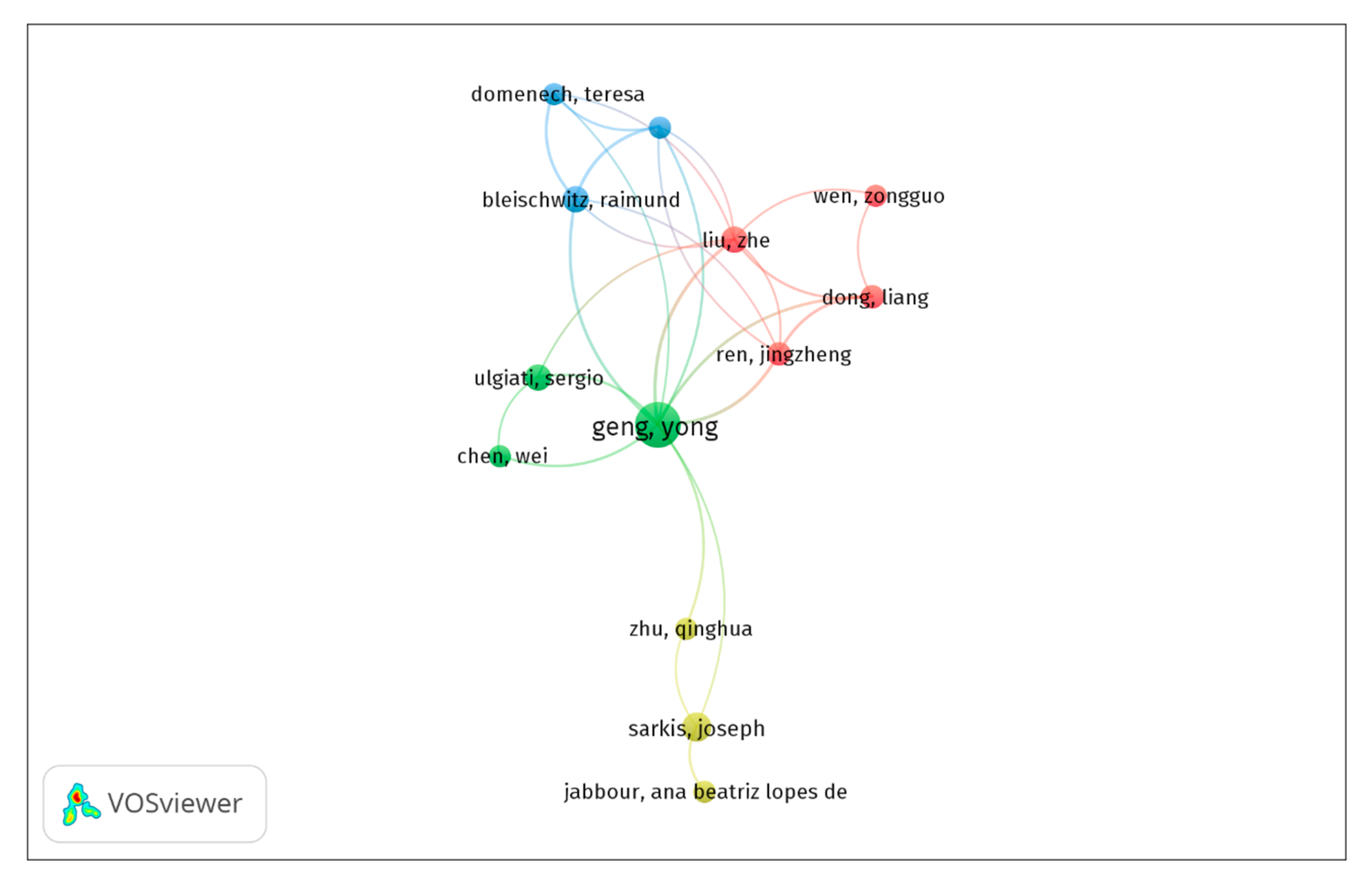
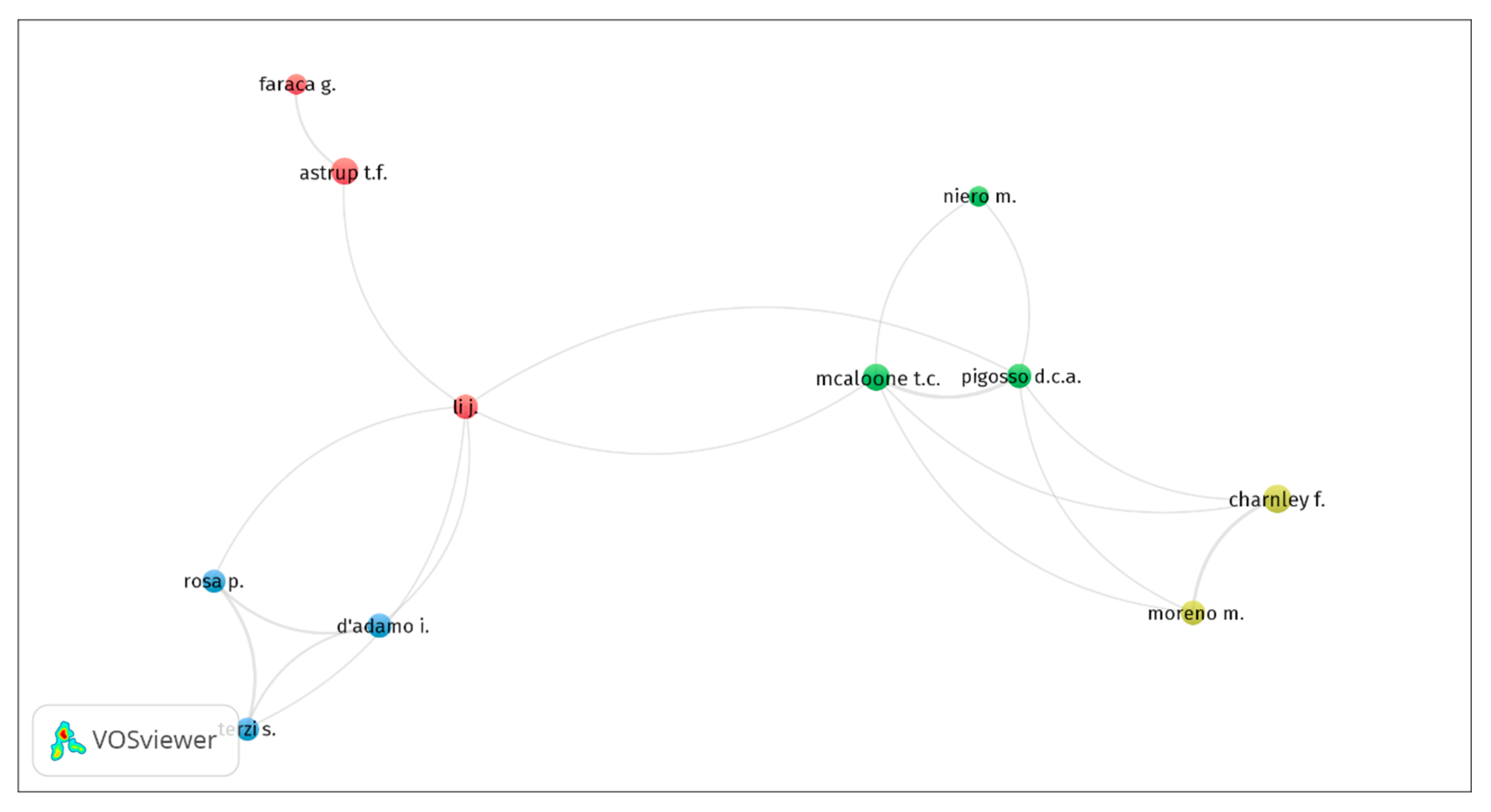
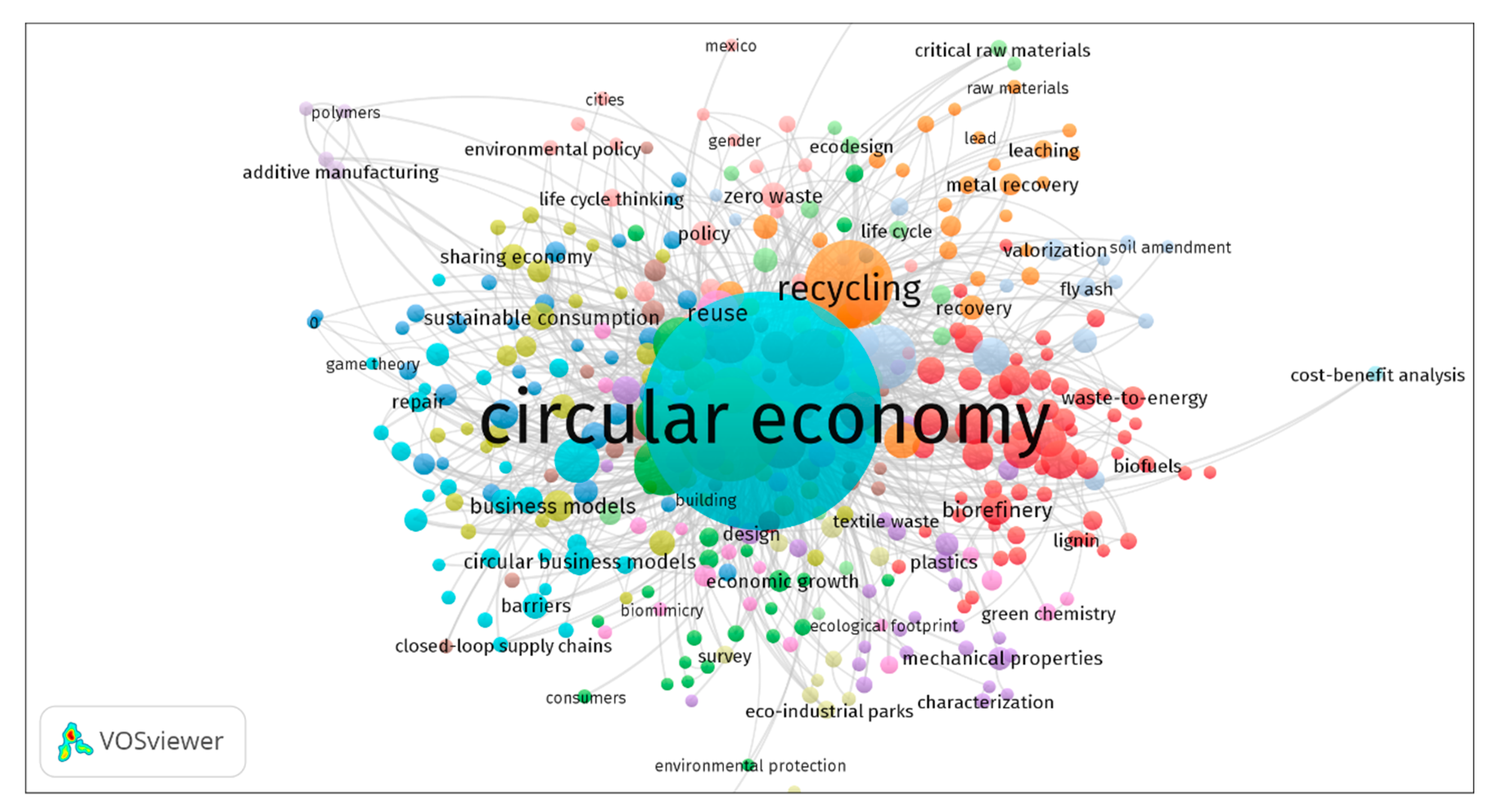
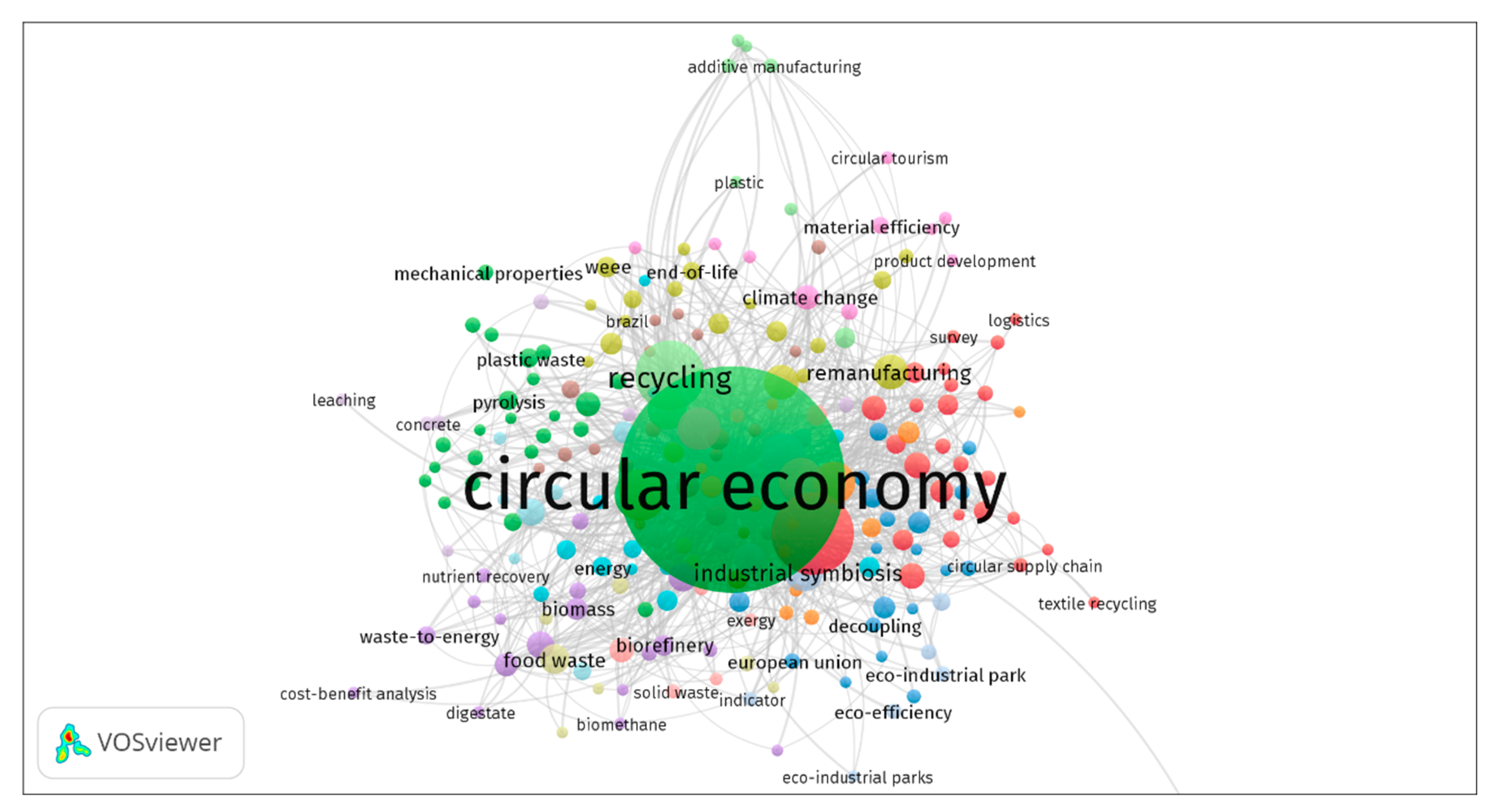
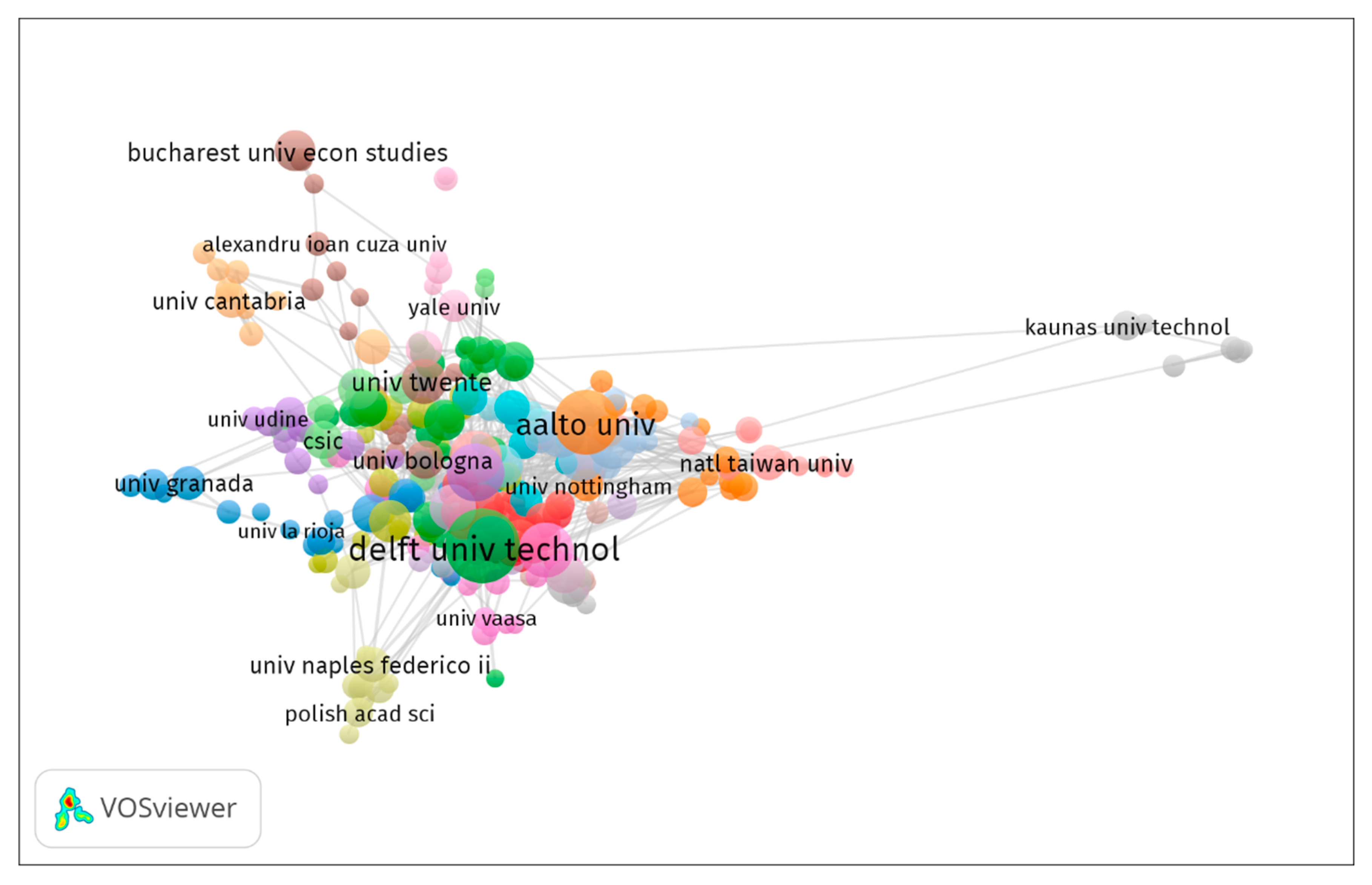
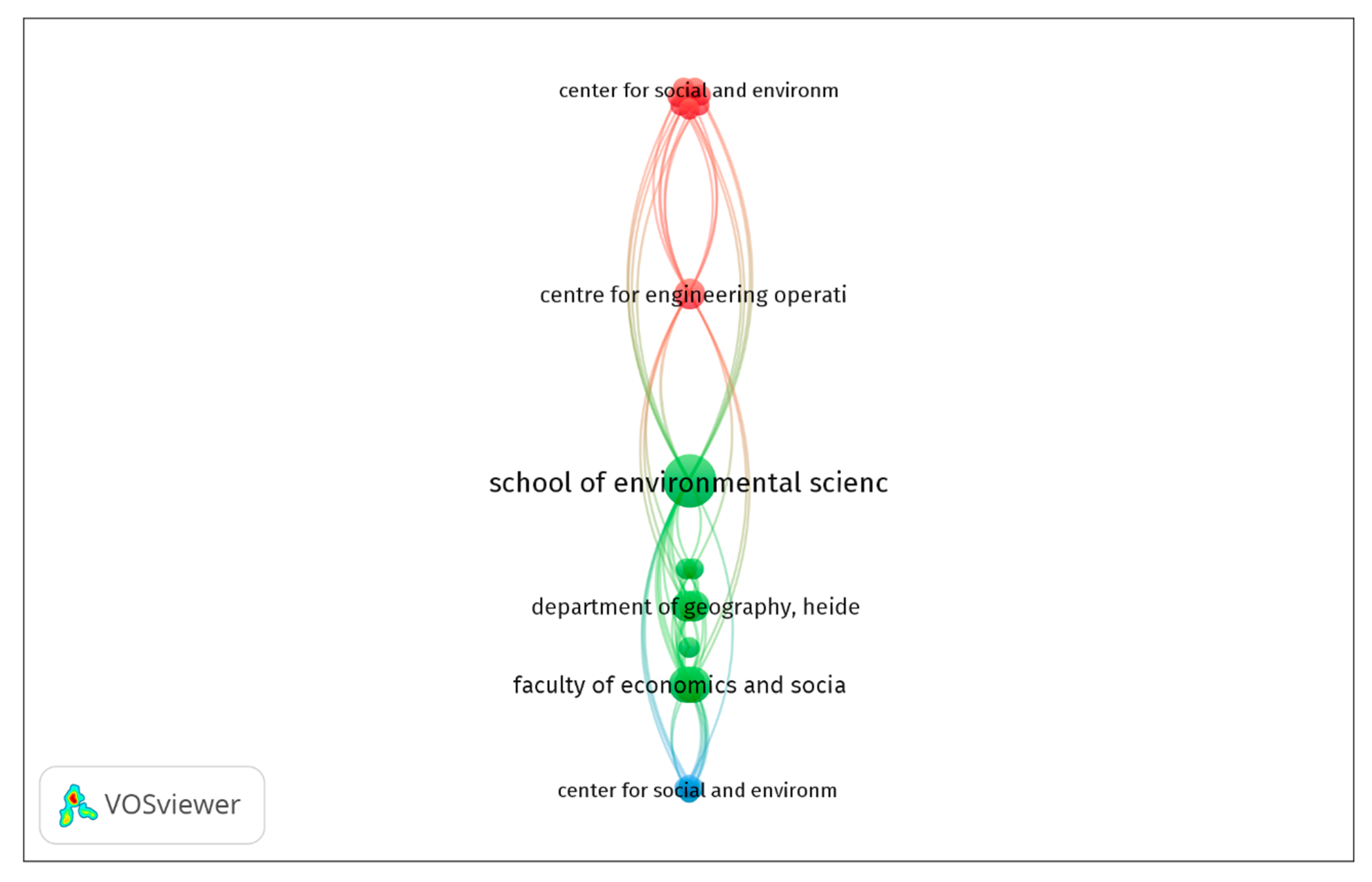
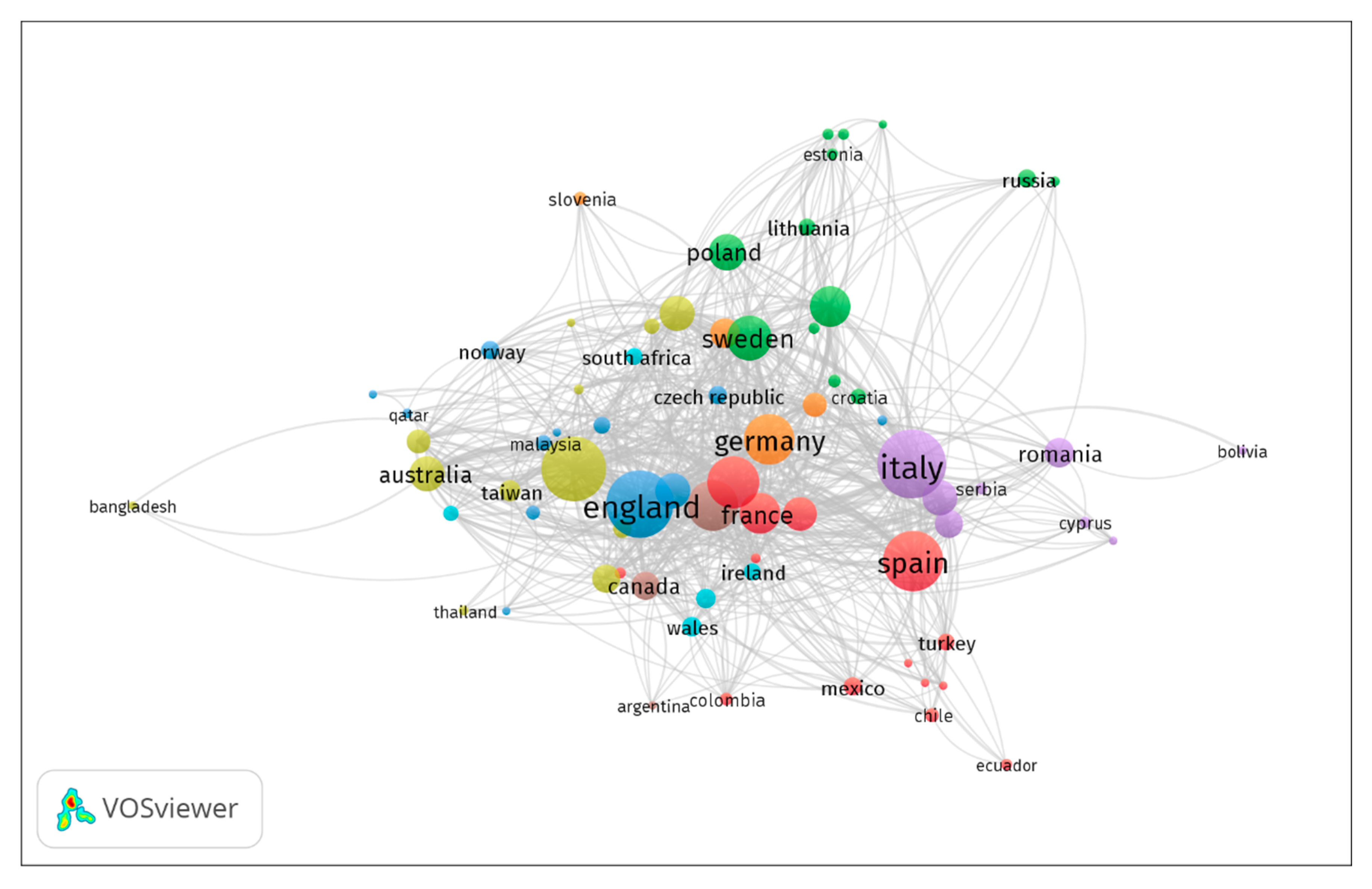
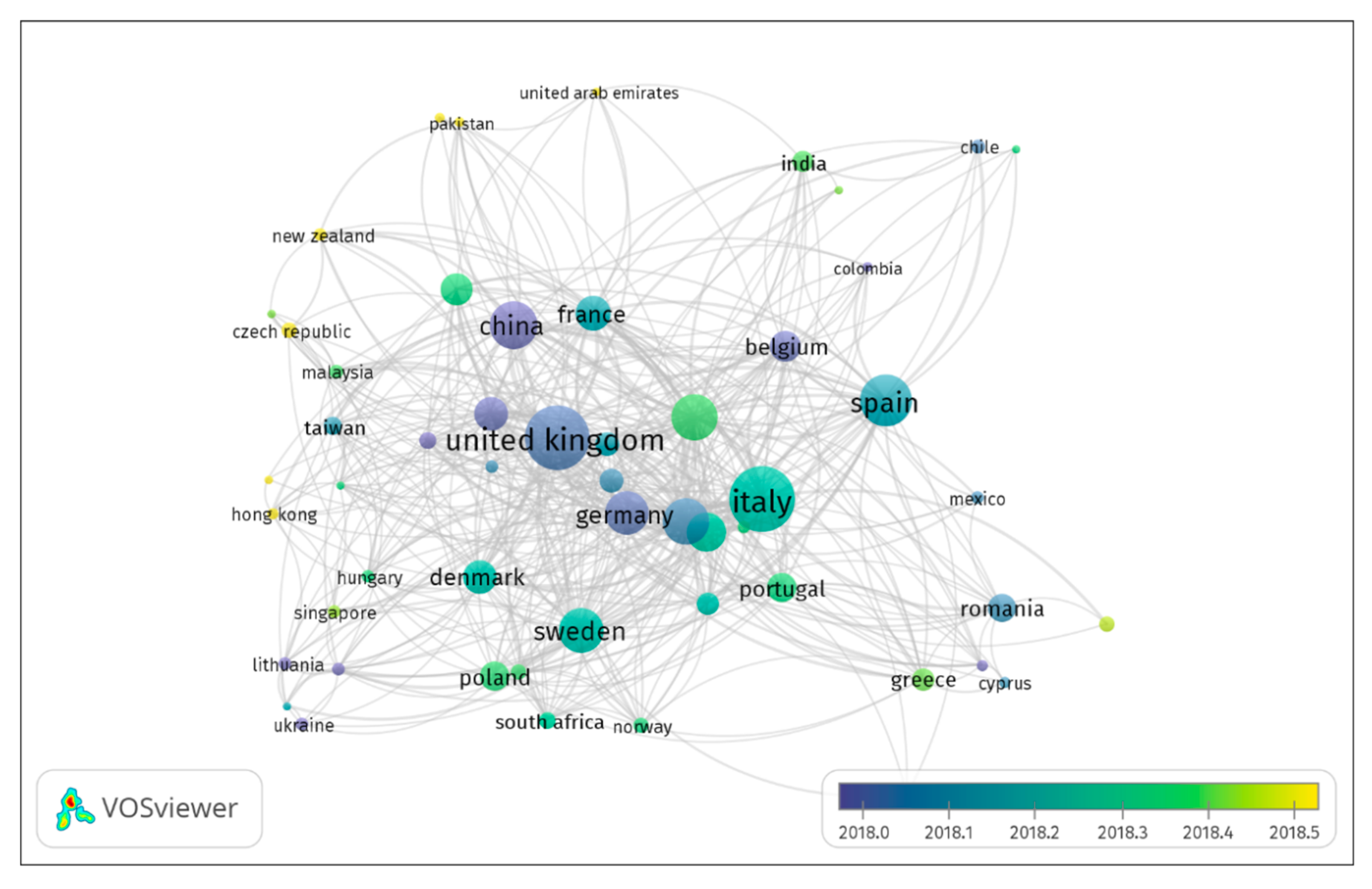
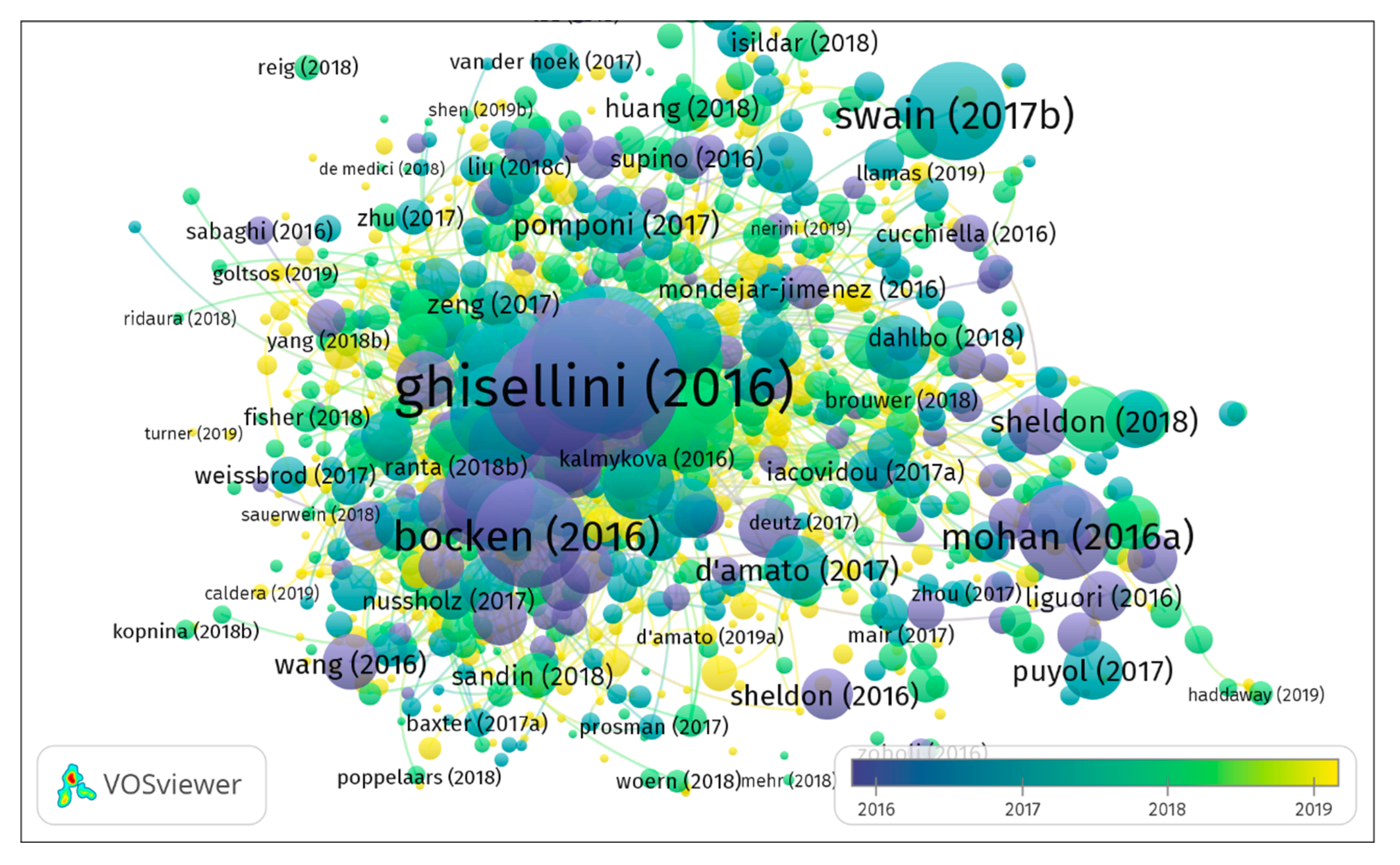
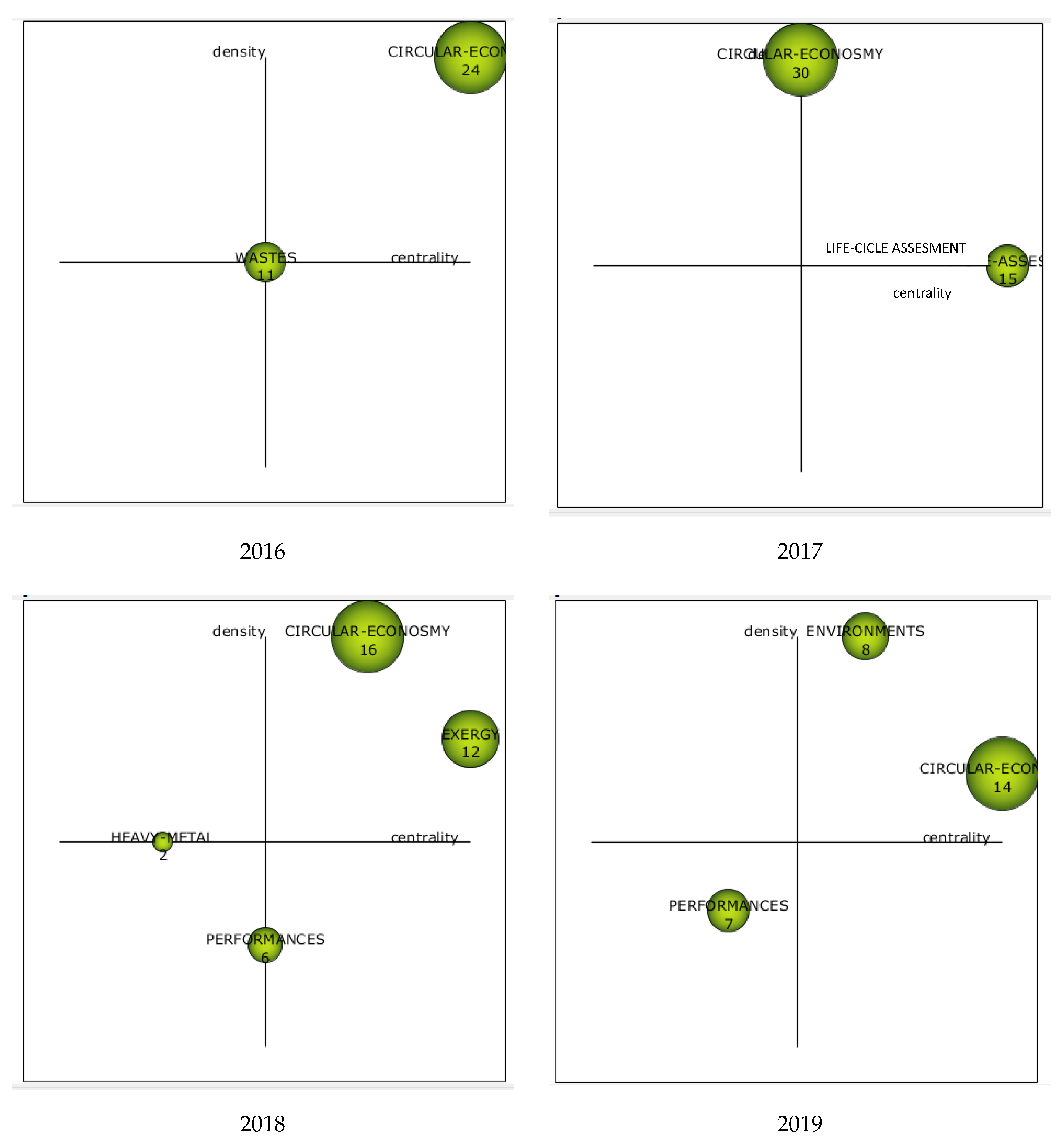
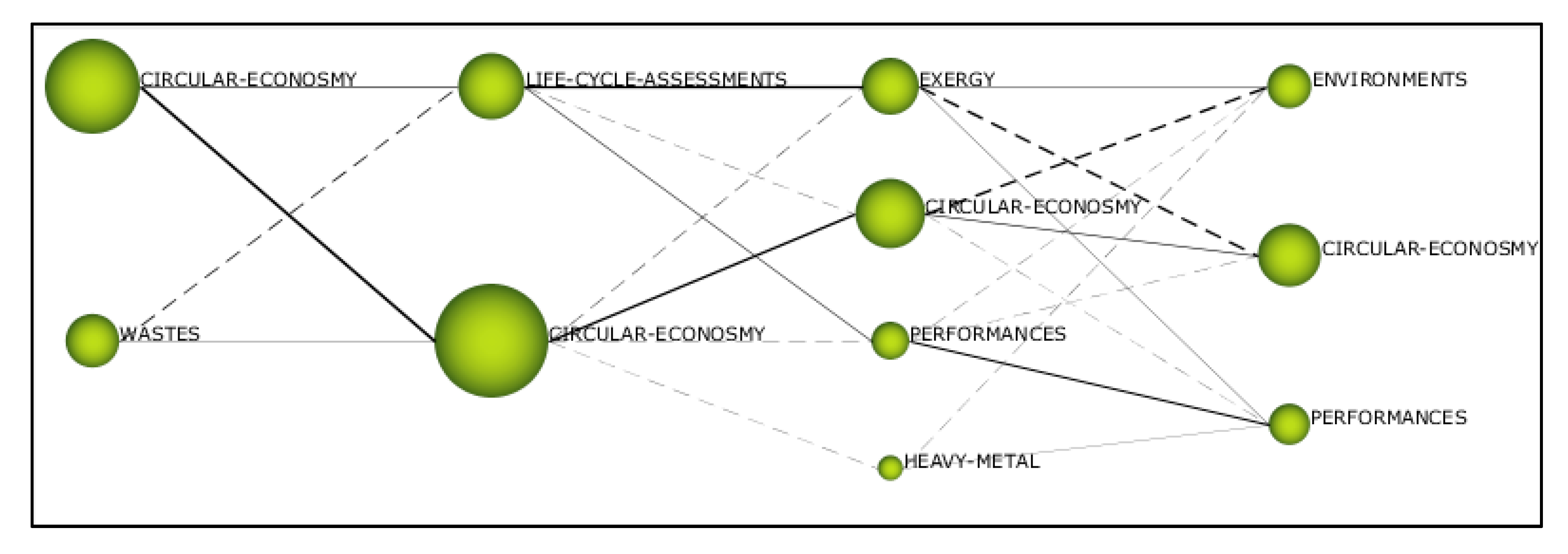
| Database Name | Resulting Values |
|---|---|
| Web of Science | 3391 records |
| Scopus | 1901 records |
| Google Scholar Metrics | 36,300 records |
| Number | Item Title | Authors | Year of Publication | Citations Received |
|---|---|---|---|---|
| 1 | A review on circular economy: the expected transition to a balanced interplay of environmental and economic systems | Ulgiati, S.; Ghisellini, P.; Cialani, C. | 2016 | 642 |
| 2 | The Circular Economy—A new sustainability paradigm? | Bocken, N.M.P.; Geissdoerfer, M.; Hultink, E.J.; Savaget, P. | 2017 | 483 |
| 3 | Sustainability and on situ monitoring in battery development | Grey, C.P.; Tarascon, J.M. | 2017 | 365 |
| 4 | Towards circular economy implementation: a comprehensive review in context of manufacturing industry | Lieder, M.; Rashid, A. | 2016 | 333 |
| 5 | Conceptualizing the circular economy: An analysis of 114 definitions | Reike, D.; Kirchherr, J.; Hekkert, M. | 2017 | 307 |
| 6 | Product design and business model strategies for a circular economy | Bocken, N.M.P.; Bakker, C.; de Pauw, I.; van der Grinten, B. | 2016 | 268 |
| 7 | The Circular economy: an interdisciplinary exploration of the concept and application in a global context | Murray, A.; Skene, K.; Haynes, K. | 2017 | 236 |
| 8 | The E factor 25 years on: the rise of green chemistry and sustainability | Sheldon, R.A. | 2017 | 232 |
| 9 | Circular economy | Stahel, W.R. | 2016 | 229 |
| 10 | Recovery and recycling of lithium: A review | Swain, B. | 2017 | 219 |
| Number | Author | Papers Published |
|---|---|---|
| 1 | Geng, Y. | 22 |
| 2 | Lundstrom, M. | 13 |
| 3 | Purnell, P. | 11 |
| 4 | Irabien, A. | 11 |
| 5 | Charnley, F. | 11 |
| 6 | Niero, M. | 11 |
| 7 | Qi, J. | 11 |
| 8 | Zhao, J. | 11 |
| 9 | Li, W. | 11 |
| 10 | Peng, X. | 11 |
| 11 | Wu, B. | 11 |
| 12 | Wang, H. | 11 |
| Number | Journal Title | Number of Documents Published |
|---|---|---|
| 1 | Journal of cleaner production | 438 |
| 2 | Sustainability | 259 |
| 3 | Resources conservation and recycling | 163 |
| 4 | Waste management | 96 |
| 5 | Journal of industrial ecology | 58 |
| 6 | Science of the total environment | 52 |
| 7 | Waste management & research | 48 |
| 8 | Journal of environmental management | 40 |
| 9 | Energies | 34 |
| 10 | Bioresource technology | 34 |
| Year | Number of Items | Percentage | Growth |
|---|---|---|---|
| 2016 | 294 | 9% | 0% |
| 2017 | 576 | 17% | 8% |
| 2018 | 987 | 29% | 12% |
| 2019 | 1534 | 45% | 16% |
| Total | 3391 | 100% | N/A |
| Number | Item Title | Authors | Year of Publication | Citations Received |
|---|---|---|---|---|
| 1 | A review on circular economy: The expected transition to a balanced interplay of environmental and economic systems | Ulgiati, S.; Ghisellini, P.; Cialani, C. | 2016 | 821 |
| 2 | The Circular Economy—A new sustainability paradigm? | Bocken, N.M.P.; Geissdoerfer, M.; Hultink, E.J.; Savaget, P. | 2017 | 619 |
| 3 | Towards circular economy implementation: A comprehensive review in context of manufacturing industry | Lieder, M.; Rashid, A. | 2016 | 431 |
| 4 | Conceptualizing the circular economy: An analysis of 114 definitions | Kirchherr, J.; Reike, D.; Hekkert, M. | 2017 | 424 |
| 5 | The Circular economy: an interdisciplinary exploration of the concept and application in a global context | Murray, A.; Skene, K.; Haynes, K. | 2017 | 342 |
| 6 | Product design and business model strategies for a circular economy | Bakker, C.; Bocken, N.M.P.; de Pauw, I.; van der Grinten, B. | 2016 | 341 |
| 7 | Circular economy: The concept and its limitations | Korhonen, J.; Honkasalo, A.; Sepp., J. | 2018 | 263 |
| 8 | Sustainable supply chain management and the transition towards a circular economy: evidence and some applications | Genovese, A.; Acquaye, A.A.; Koh, S.C.L.; Figueroa, A. | 2017 | 226 |
| 9 | Designing the business models for circular economy-towards the conceptual framework | Lewandowski, M. | 2016 | 221 |
| 10 | Environmental sciences, sustainable development and circular economy: alternative concepts for trans-disciplinary research | Bernard, S.; Sauvé, S.; Sloan, P. | 2016 | 178 |
| Number | Author | Articles Published |
|---|---|---|
| 1 | Lundstrom, M. | 15 |
| 2 | Liu, Y. | 9 |
| 3 | Charnley, F. | 9 |
| 4 | Molina-Moreno, V. | 9 |
| 5 | McAloone, T.C. | 8 |
| 6 | Wilson, B.P. | 8 |
| 7 | Wang, Y. | 8 |
| 8 | Prieto-Sandoval, V. | 8 |
| 9 | Kulczycka, J. | 8 |
| 10 | Astrup, T.F. | 8 |
| 11 | Purnell, P. | 8 |
| 12 | Geng, Y. | 8 |
| Number | Journal Title | Number of Documents Published |
|---|---|---|
| 1 | Journal of Cleaner Production | 280 |
| 2 | Sustainability (Switzerland) | 183 |
| 3 | Resources, Conservation and Recycling | 109 |
| 4 | Waste Management | 60 |
| 5 | Journal of Industrial Ecology | 43 |
| 6 | Science of the Total Environment | 31 |
| 7 | Came environmental science, engineering and management | 30 |
| 8 | Journal of Environmental Management | 23 |
| 9 | Waste Management and Research | 20 |
| 10 | Bioresource Technology | 18 |
| Year | Number of Items | Percentage | Growth |
|---|---|---|---|
| 2016 | 132 | 7% | 0% |
| 2017 | 311 | 16% | 9% |
| 2018 | 575 | 30% | 14% |
| 2019 | 883 | 46% | 16% |
| Total | 1901 | 100% | N/ |
| Number | Item Title | Authors | Year of Publication | Citations Received |
|---|---|---|---|---|
| 1 | Conceptualizing the circular economy: An analysis of 114 definitions | Kirchherr, J.; Reike, D.; Hekkert, M. | 2017 | 764 |
| 2 | The Circular Economy—A new sustainability paradigm? | Bocken, N.M.P.; Geissdoerfer, M.; Hultink, E.J.; Savaget, P. | 2017 | 1187 |
| 3 | Product design and business model strategies for a circular economy | Bakker, C.; Bocken, N.M.P.; de Pauw, I.; van der Grinten, B. | 2016 | 727 |
| 4 | Circular economy: the concept and its limitations | Korhonen, J.; Honkasalo, A.; Sepp. l., J. | 2018 | 526 |
| 5 | Circular economy rebound | Zink, T; Geyer, R. | 2017 | 203 |
| 6 | Towards circular economy implementation: a comprehensive review in context of manufacturing industry | Lieder, M.; Rashid, A. | 2016 | 431 |
| 7 | The Circular economy: an interdisciplinary exploration of the concept and application in a global context | Murray, A.; Skene, K.; Haynes, K. | 2017 | 342 |
| 8 | Designing the business models for circular economy-towards the conceptual framework | Lewandowski, M. | 2016 | 221 |
| 9 | A review on circular economy: the expected transition to a balanced interplay of environmental and economic systems | Ulgiati, S.; Ghisellini, P.; Cialani, C. | 2016 | 821 |
| 10 | Circular economy as an essentially contested concept | Korhonen, J.; Nuur, C.; Feldmann, A.; Birkie, S.E. | 2018 | 207 |
| Number | Item Title | Authors | Journal Title | Year |
|---|---|---|---|---|
| 1 | A review where to circulate economy: the expected transition tone a balanced interplay of environmental and economic systems | Ulgiati, S.; Ghisellini, P.; Cialani, C. | Journal of Cleaner Production Vol. 114, pp. 11–32 | 2016 |
| 2 | The Circular economy—A new sustainability paradigm? | Bocken, N.M.P.; Geissdoerfer, M.; Hultink, E.J.; Savaget, P. | Journal of Cleaner Production Vol. 143, pp. 757–768 | 2017 |
| 3 | Towards circular economy implementation: a comprehensive review in context of manufacturing industry | Lieder, M.; Rashid, A. | Journal of Cleaner Production Vol. 115, pp. 36–51 | 2016 |
| 4 | Conceptualizing the circular economy: an analysis of 114 definitions | Reike, D.; Kirchherr, J.; Hekkert, M. | Resources Conservation and Recycling Vol. 127, pp. 221–232 | 2017 |
| 5 | Product design and business model strategies for a circular economy | Bocken, N.M.P.; Bakker, C.; de Pauw, I.; van der Grinten, B. | Journal of Industrial and Production Engineering Vol. 33, No. 5, pp. 308–320 | 2016 |
| 6 | The Circular economy: an interdisciplinary exploration of the concept and application in a global context | Murray, A.; Skene, K.; Haynes, K. | Journal of Business Ethics Vol. 140, No. 3, pp. 369–380 | 2017 |
| Author | Affiliation | Country |
|---|---|---|
| Ghisellini, P. | Università de Bologna, Alma mater Studiorum, Department of Agricultural, Food Science & Technology | Italy |
| Cialani, C. | Dalarna University, School of Technology & Business Studies, Econ Unido, S-79188 Falun, Sweden | Sweden |
| Ulgiati, S. | Parthenope University Naples, Department of Science & Technology, Y-80143 Naples, Italy Beijing Normal University, School of Environment, Beijing, Peoples R China | Italy China |
| Geissdoerfer, M. | Univeristy of Cambridge, Department of Engineering, Institute for Manufacturing, Cambridge CB3 0FS, England Delft University of Technology, Industrial Design Engineering, Landbergstr 15, NL-2628 CE Delft, Netherlands | United Kingdom Netherlands |
| Savaget, P. | Univeristy of Cambridge, Department of Engineering, Institute for Manufacturing, Cambridge CB3 0FS, England Delft University of Technology, Industrial Design Engineering, Landbergstr 15, NL-2628 CE Delft, Netherlands | United Kingdom Netherlands |
| Bocken, N.M.P. | Univeristy of Cambridge, Department of Engineering, Institute for Manufacturing, Cambridge CB3 0FS, England Delft University of Technology, Industrial Design Engineering, Landbergstr 15, NL-2628 CE Delft, Netherlands | United Kingdom Netherlands |
| Hultink, E.J. | Delft University of Technology, Industrial Design Engineering, Landbergstr 15, NL-2628 CE Delft, Netherlands | Netherlands |
| Lieder, M. | KTH Royal Institute of Technology, Department of Production Engineering, Brinellvagen 68, SE-10044 Stockholm, Sweden. | Sweden |
| Rashid, A. | KTH Royal Institute of Technology, Department of Production Engineering, Brinellvagen 68, SE-10044 Stockholm, Sweden. | Sweden |
| Kirchherr, J. | Utrecht University, Copernicus Institute for Sustainable Development, Innovation Studies Group, Heidelberglaan 2, NL-3584 CS Utrecht, Netherlands | Netherlands |
| Reike, D. | Utrecht University, Copernicus Institute for Sustainable Development, Innovation Studies Group, Heidelberglaan 2, NL-3584 CS Utrecht, Netherlands | Netherlands |
| Hekkert, M. | Utrecht University, Copernicus Institute for Sustainable Development, Innovation Studies Group, Heidelberglaan 2, NL-3584 CS Utrecht, Netherlands | Netherlands |
| by Pauw, I. | IDEAL & Co Desing and Explore, Amsterdam, Netherlands | Netherlands |
| Bakker, C. | Delft University of Technology, Industrial Design Engineering, Landbergstr 15, NL-2628 CE Delft, Netherlands | Netherlands |
| van der Grinten, B. | IDEAL & Co Desing and Explore, Amsterdam, Netherlands | Netherlands |
| Murray, A. | Kings School Winchester, Hoare Chair Responsible Management, Romsey Rd, Winchester SOUND22 5HT, Hants, England | United Kingdom |
| Skene, K. | Biosphere Research Institute London, England | United Kingdom |
| Haynes, K. | Newcastle University, School Business, Northern Zoco Chair Accounting & Finance, 5 Barrack Rd, Newcastle Upon Tyne NE1 4SE, Tyne & Wear, England | United Kingdom |
| Journal of cleaner production |
| Resources conservation and recycling |
| Journal of Business Ethics |
| Title | Country of Editing | Publishing | JCR Category | Category Scopus |
|---|---|---|---|---|
| Journal of cleaner production | Netherlands | Elsevier | Environmental Sciences Engineering, Environmental Green and Sustainable Science and Technology | Environmental Science: General environmental Science Business, Management and Accounting: Strategy and Management Engineering: Industrial and Manufacturing Engineering Energy: Renewable Energy, Sustainability and the Environment |
| Resources conservation and recycling | Netherlands | Elsevier | Environmental Sciences Engineering, Environmental | Economics, Econometrics and Financial: Economics and Econometrics Environmental Science: Waste Management and Disposal |
| Journal of Business Ethics | Netherlands | Springer | Business Ethics | Social Sciences: Law Arts and Humanities: Arts and Humanities (miscellaneous) Business, Management and Accounting: General Business, Management and Accounting |
| Number | Item Title | Authors | Incorporated into Your Mendeley | Citations Received at WoS | Citations Received on Scopus |
|---|---|---|---|---|---|
| 1 | A review on circular economy: the expected transition to a balanced interplay of environmental and economic systems | Ulgiati, S.; Ghisellini, P.; Cialani, C. | 2816 | 642 | 821 |
| 2 | The Circular economy: a new sustainability paradigm? | Bocken, N.M.P.; Geissdoerfer, M.; Hultink, E.J.; Savaget, P. | 2930 | 483 | 619 |
| 3 | Towards circular economy implementation: a comprehensive review in context of manufacturing industry | Lieder, M.; Rashid, A. | 1603 | 333 | 431 |
| 4 | Conceptualizing the circular economy: an analysis of 114 definitions | Reike, D.; Kirchherr, J.; Hekkert, M. | 2153 | 307 | 424 |
| 5 | Product design and business model strategies for a circular economy | Bocken, N.M.P.; Bakker, C.; de Pauw, I.; van der Grinten, B. | 1636 | 268 | 341 |
| 6 | The Circular economy: an interdisciplinary exploration of the concept and application in a global context | Murray, A.; Skene, K.; Haynes, K. | 1497 | 236 | 342 |
| Total readers who have added the articles to their Mendeley | 12,635 | ||||
| Papers Users by Area of Knowledge According to Mendeley | ||||||
|---|---|---|---|---|---|---|
| Item Title | Business Sciences | Environmental Sciences | Engineering | Social Sciences | Design | Economy |
| A review on circular economy: the expected transition to a balanced interplay of environmental and economic systems | 28% | 30% | 30% | 12% | - | - |
| The Circular economy: a new sustainability paradigm? | 32% | 27% | 30% | 11% | - | - |
| Towards circular economy implementation: a comprehensive review in context of manufacturing industry | 31% | 26% | 35% | - | - | 9% |
| Conceptualizing the circular economy: an analysis of 114 definitions | 30% | 30% | 28% | - | - | 12% |
| Product design and business model strategies for a circular economy | 35% | 22% | 30% | - | 13% | - |
| The Circular economy: an interdisciplinary exploration of the concept and application in a global context | 39% | 26% | 21% | 14% | - | - |
| PlumX Metrics | ||||||
|---|---|---|---|---|---|---|
| Item Title | Uses | Mentions to Blogs | Press | Wikipedia | Tweets Made | |
| A review where to circulate economy: the expected transition tone a balanced interplay of environmental and economic systems | 2520 | 4 | 1 | 1 | 2 | |
| The Circular economy: a new sustainability paradigm? | 1961 | 2 | 13 | 3 | 4 | 6 |
| Towards circular economy implementation: a comprehensive review in context of manufacturing industry | 1370 | 3 | 2 | 5 | ||
| Conceptualizing the circular economy: an analysis of 114 definitions | 760 | 11 | 4 | 58 | 1 | 76 |
| Product design and business model strategies for a circular economy | 1217 | 2 | 1 | 1 | 0 | |
| The Circular economy: an interdisciplinary exploration of the concept and application in a global context | 4640 | 2 | 1 | 2 | 2 | 26 |
| Total | 12,468 | 24 | 20 | 66 | 8 | 115 |
© 2020 by the authors. Licensee MDPI, Basel, Switzerland. This article is an open access article distributed under the terms and conditions of the Creative Commons Attribution (CC BY) license (http://creativecommons.org/licenses/by/4.0/).
Share and Cite
Camón Luis, E.; Celma, D. Circular Economy. A Review and Bibliometric Analysis. Sustainability 2020, 12, 6381. https://doi.org/10.3390/su12166381
Camón Luis E, Celma D. Circular Economy. A Review and Bibliometric Analysis. Sustainability. 2020; 12(16):6381. https://doi.org/10.3390/su12166381
Chicago/Turabian StyleCamón Luis, Enric, and Dolors Celma. 2020. "Circular Economy. A Review and Bibliometric Analysis" Sustainability 12, no. 16: 6381. https://doi.org/10.3390/su12166381
APA StyleCamón Luis, E., & Celma, D. (2020). Circular Economy. A Review and Bibliometric Analysis. Sustainability, 12(16), 6381. https://doi.org/10.3390/su12166381





